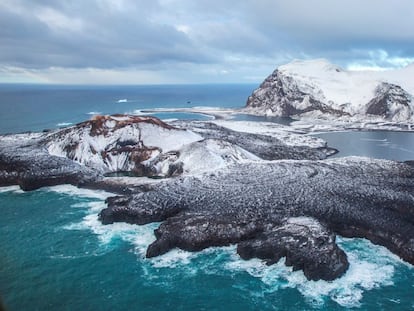How the Earth’s inner core affects weather and climate events
The decrease of the rotation velocity of the planet’s inner core has imperceptible effects for humans, but it is essential to understand

Geologists often remark that humans know more about outer space than about the heart of our own planet. We tend to think that Earth functions as a perfectly synchronized compact system, but that is not the case. A new study confirms that the Earth’s inner core has stopped moving in recent years. So what does that discovery mean, and how does it affect us?
The discovery
Since 2009, the rotation velocity of the inner core, a metal sphere with a radius of 1,200 kilometers (745 miles) at the center of the Earth, has slowed down. The same thing happened at the beginning of the 1970s, and then its velocity picked up again. This demonstrates that the inner core does not turn at the same rhythm as the crust, the exterior layer of the planet where humans live, which has a much larger radius: 6,378 kilometers (3,963 miles). It is possible that the inner core follows a cycle of fluctuations that could last some seven decades.
What does it mean that the planet’s inner core has stopped? Xiaoming Song, the study’s main author, explains it like this: “When we look at Earth from space, the inner core turns almost at the same rhythm as the mantle and the surface, in an eastward direction and in a 24-hour cycle. We know from previous studies that the rotation velocity of the inner core is not exactly the same. In our new study, using the surface of the Earth as a point of reference, we infer that the inner core turned eastward, and moved more quickly than the crust, from the middle of the 1970s until 2009. Since then, the inner core has slowed down, and now it turns a bit more towards the west, that is, slower than the surface.”
The effect
The impact of this phenomenon on a planetary level is very, very small. The Earth completes a 360-degree turn around itself every day. The study detected a difference of 0.1 degrees per year. The asynchrony could affect the duration of the day, but it is imperceptible to humans. The study’s authors calculate that the day could be a thousandth of a second longer or shorter than it was 50 years ago, depending on the rotation velocity of the inner core. Those effects have no direct impact on the life of earthlings, but it may require adjustments to the planet’s most precise atomic clocks, introducing leap seconds, for example.

The observed effect could cause minimal deformations in the earth’s crust, which could influence the sea level, according to Song. Additionally, effects on Earth’s magnetic field could have an effect on climate, the study authors argue. But for now, those effects are just a hypothesis that more studies will have to confirm, as Maurizio Mattesini, a geophysicist who specializes in the internal structure of the Earth, emphasizes. “It is suspected that the effect observed could have an impact on the climate, but there is no evidence. The authors suggest that there is, and, of course, now it will have to be studied,” Mattesini adds.
Earth stops
The inner core of the Earth is one of the most violent places imaginable. The solid metal sphere floats in a liquid ocean of iron and other metals: the outer core. Its behavior is governed by two forces. The force of gravity, generated by the rotation of the crust and the mantle, moves the nucleus with it. Additionally, the rotation of the solid inner core inside the liquid generates a powerful magnetic field that influences the rotation velocity. The interaction of these and other forces explain why the inner core turns at a rate slightly higher or lower than the crust, and that it may have an impact on the magnetic field.
Earth is turning more slowly than before. The decreased velocity is partly due to the rise and fall of the tides, caused by the force of gravity of the moon, which cause friction that slows down the crust. These forces also cause the moon to move away from the Earth at a constant rhythm of 3.8 centimeters per year, which also slows down the Earth’s crust. In this case, the effects are also very, very small: in 100 years, the day will be 1.4 thousandths of a second longer. Even as it moves away, it is not likely that the moon will ever escape from the Earth’s orbit — at least not before the Sun burns up the earth in seven billion years.
A distant future
4.5 billion years ago, our planet was a high-temperature mass of liquid and gaseous particles. Over millions of years, the planet cooled down. The heaviest compounds, like iron, sank into the interior to form the inner core, while the minerals that make up the mantle and crust remained towards the surface.
No one knows exactly when that core was formed, although recent estimations point to one billion years ago, says Puy Ayarza, director of the Geology Department at the University of Salamanca. Each year, part of the liquid metals of the external core solidify and thicken the inner core, whose radius grows by one millimeter each year. A moment will come when the entire liquid core will solidify, and the Earth’s magnetic field will disappear, which will cause an end to life on the planet. In any case, Ayarza says, that will not happen for thousands of millions of years.
The geologist offers another example of the magnitude of these phenomena. In December 2004, an earthquake with a magnitude of 9.2 in Sumatra, and the following tsunami, caused thousands of deaths in Asia. “That earthquake made the Earth vibrate for four months. It even slightly displaced its axis of rotation. But no one noticed it. These are imperceptible changes. In the same way, the oscillation of the inner core has happened before, and it will happen again, without us noticing.”
The new study has opened up fresh lines of investigation that will allow us to better understand the Earth’s behavior and its future. But it also makes clear the limitations of human technology. The primary way to understand the workings of the inner core, more than 5,000 kilometers (3,100 miles) below the surface, is to study earthquakes that cross the planet. According to Song, a geologist at the Institute of Theoretical and Applied Geophysics at Peking University, two main issues remain. The first is constructing data models that can simulate with precision the cycles that the Earth’s inner core seems to be following, a challenge for existing computers. To do so, it is necessary to have more data about earthquakes that cross the planet. The current database only goes back to the mid-1960s, Song says. “It is expected that the inner core will continue turning east, in relation to the surface, in the coming years, even decades. Seismic waves are still the best method to study the inner core, so improving high-quality seismic networks should be our priority,” he adds.
Sign up for our weekly newsletter to get more English-language news coverage from EL PAÍS USA Edition










































